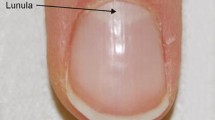Abstract
Onychomycosis and tinea pedis are common superficial infections caused primarily by dermatophytes. The aim of this investigation was to study the epidemiology, etiological agents, and potential risk factors for infection based on comparison of athletes and non-athletes from a northern region of Rio Grande do Sul (Brazil). Each group consisted of 100 male individuals with ages ranging from 18 to 40 years. After a clinical examination, samples were taken from individuals presenting signs of onychomycosis and/or tinea pedis for direct microscopic examination and culture. Among the athletes, the frequency of onychomycosis and/or tinea pedis was 32%, and for the control group, it was 20%. The athletes presented 16% of onychomycosis, 12% of tinea pedis, and 4% of onychomycosis and tinea pedis together. The distribution in the control group was 10% of onychomycosis, 7% of tinea pedis, and 3% of this association. The pathogens identified were dermatophytes (84.8%) and yeasts (15.2%), and the most commonly identified organism was Trichophyton rubrum, followed by Trichophyton mentagrophytes var. interdigitale. No significant differences were found when the frequency of species distribution in the athletes and non-athlete groups was compared. Risk factors for onychomycosis in athletes included familial cases of fungal infection, contact with domestic animals, and nail trauma, while the risk factors in non-athletes included the habit of not using sandals in public bathrooms and nail trauma. For tinea pedis, the habit of not using sandals in public bathrooms was a predisposing factor in both groups, while hyperhydrosis was a risk factor only in non-athletes. This study concludes that despite the higher number of fungal infections in athletes, there is no significant difference between these groups.
Similar content being viewed by others
References
Caputo R, De Boulle K, Del Rosso J, Nowicki R. Prevalence of superficial fungal infections among sports-active individuals: results from the Achilles survey, a review of the literature. J Eur Acad Dermatol Venereol. 2001;15:312–6.
Attye A, Auger P, Joly J. Incidence of occult athlete’s foot in swimmers. Eur J Epidemiol. 1990;6:244–7.
Djeridane A, Djeridane Y, Ammar-Khodja A. Epidemiological and aetiological study on tinea pedis and onychomycosis in Algeria. Mycoses. 2006;49:190–6.
Perea S, Ramos MJ, Garau M, Gonzalez A, Noriega AR, del Palacio A. Prevalence and risk factors of tinea unguium and tinea pedis in the general population in Spain. J Clin Microbiol. 2000;38:3226–30.
Baran R, Hay R, Haneke E, Tosti A. Onychomycosis the current approach to diagnosis and therapy. Oxon: Taylor and Francis; 2006.
Mistik S, Ferahbas A, Koc AN, Ayangil D, Ozturk A. What defines the quality of patient care in tinea pedis? J Eur Acad Dermatol Venereol. 2006;20:158–65.
Field LA, Adams BB. Tinea pedis in athletes. Int J Dermatol. 2008;47:485–92.
Purim KS, Bordignon GP, Queiroz-Telles F. Fungal infection of the feet in soccer players and non-athlete individuals. Rev Iberoam Micol. 2005;22:34–8.
Sigurgeirsson B, Steingrimsson O. Risk factors associated with onychomycosis. J Eur Acad Dermatol Venereol. 2004;18:48–51.
Olkhovskaya KB, Perlamutrov Y. Step-wise treatment of athlete’s foot (tinea pedis) using isoconazole combined with a corticosteroid followed by isoconazole alone. Mycoses. 2008;51(Suppl 4):50–1.
Pickup TL, Adams BB. Prevalence of tinea pedis in professional and college soccer players versus non-athletes. Clin J Sport Med. 2007;17:52–4.
Zaias N. Tinea pedis interdigitalis (interspace). Cutis. 2001;67:28–31.
Martelozo I, Guilhermetti E, Svidzinski TIE. Ocorrência de onicomicose em Maringá, Estado do Paraná Brasil. Maringá. 2005;27:177–82.
Perez AJ. Quem são os atletas e os não-atletas no processo de treinamento? Rev Brasil Cien Esp. 2000;21:129–32.
Gallagher D. Overweight and obesity BMI cut-offs and their relation to metabolic disorders in Koreans/Asians. Obes Res. 2004;12:440–1.
Godoy P, Nunes E, Silva V, Tomimori-Yamashita J, Zaror L, Fischman O. Onychomycosis caused by Fusarium solani and Fusarium oxysporum in Sao Paulo, Brazil. Mycopathologia. 2004;157:287–90.
De Hoog GS, Guarro J, Gene J, Figueras MJ. Atlas of clinical fungi. 2nd ed. Netherlands/Reus: Centraalbureau voor Schimmelcultures/Universitat Rovira i Virgili; 2000.
Kurtzman CP, Fell JW. A taxonomic study. 4th ed. Amsterdam: Elsevier Science; 1998.
Godoy-Martinez P, Nunes FG, Tomimori-Yamashita J, et al. Onychomycosis in São Paulo, Brazil. Mycopathology. 2009;168:111–6.
Kamihama T, Kimura T, Hosokawa JI, Ueji M, Takase T, Tagami K. Tinea pedis outbreak in swimming pools in Japan. Public Health. 1997;111:249–53.
Auger P, Marquis G, Joly J, Attye A. Epidemiology of tinea pedis in marathon runners: prevalence of occult athlete’s foot. Mycoses. 1993;36:35–41.
Purim KS, Niehues LP, Queiroz-Telles F, Leite N. Aspectos epidemiológicos de um time chinês de futebol. Revista Brasileira de Medicina do Esporte. 2006;12:16–20.
Sarma S, Capoor MR, Deb M, Ramesh V, Aggarwal P. Epidemiologic and clinicomycologic profile of onychomycosis from north India. Int J Dermatol. 2008;47:584–7.
Walsh FJ, Groll A, Hiemenz J, Fleming R, Roilides E, Anaissie E. Infections due to emerging and uncommon medically important fungal pathogens. Clin Microbiol. 2004;10:48–66.
Gupta AK, Humke S. The prevalence and management of onychomycosis in diabetic patients. Eur J Dermatol. 2001;10:379–84.
O’Donoghue NB, Moore MK, Creamer D. Onychomycosis due to Onychocola canadensis. Clin Exp Dermatol. 2003;28:283–4.
Ingordo V, Fracchiolla S, Figliola F, D’Andria G, Colecchia B, Naldi L. Prevalence and awareness of tinea pedis in Italian Sailors. Dermatology. 2000;201:349–550.
Cohen AD, Wolsk A, Alkan M, Schalev R, Vardy DA. Prevalence and risk factors for tinea pedis in Israeli soldiers. Int J Dermatol. 2005;44:1002–5.
Acknowledgments
This study was partially supported by grants from the Coordenação de Aperfeiçoamento de Pessoal de Nível Superior (CAPES), Conselho Nacional de Desenvolvimento Científico e Tecnológico (CNPq), Universidade de Passo Fundo (UPF), and Universidade Federal de São Paulo (UNIFESP).
Author information
Authors and Affiliations
Corresponding author
Rights and permissions
About this article
Cite this article
Sabadin, C.S., Benvegnú, S.A., da Fontoura, M.M.C. et al. Onychomycosis and Tinea Pedis in Athletes from the State of Rio Grande Do Sul (Brazil): A Cross-Sectional Study. Mycopathologia 171, 183–189 (2011). https://doi.org/10.1007/s11046-010-9360-z
Received:
Accepted:
Published:
Issue Date:
DOI: https://doi.org/10.1007/s11046-010-9360-z




